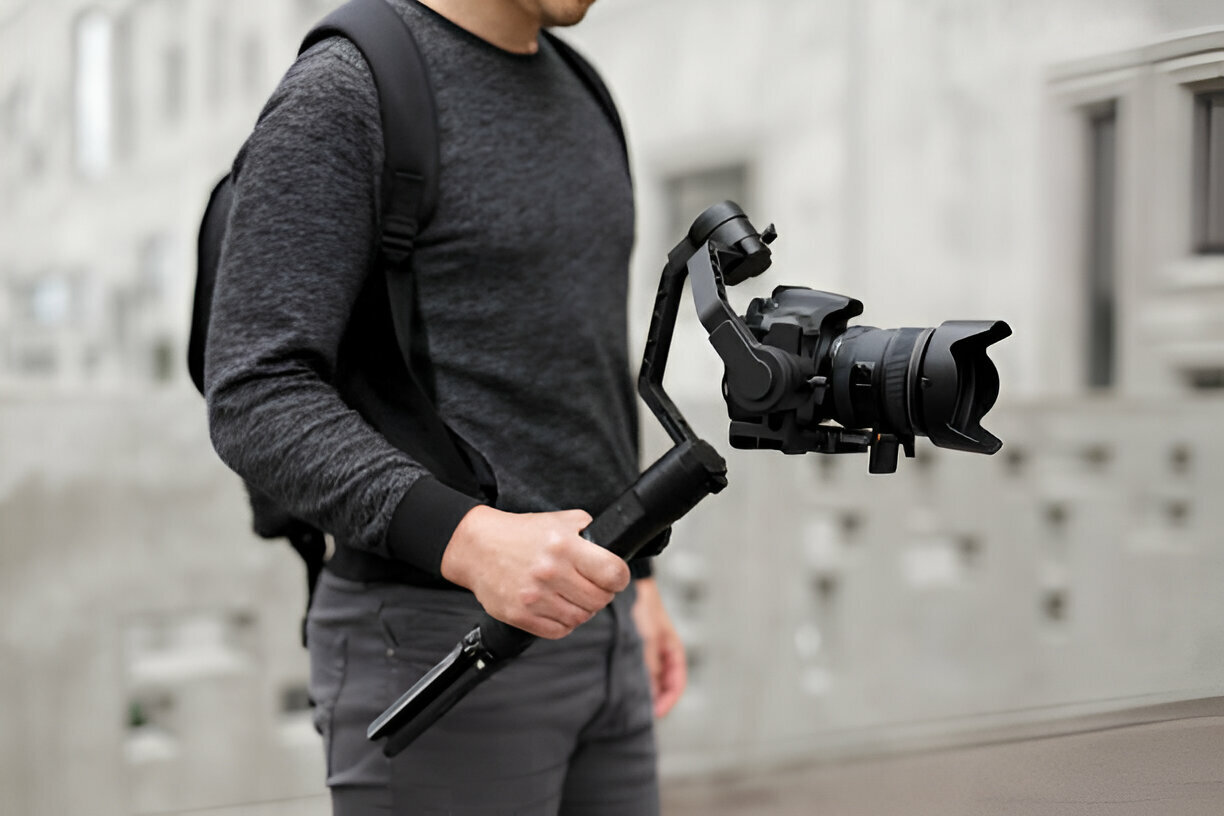- Camera
- Camera Lenses
- Camera Gimbals
- Camera Accessories
- Abs Flight Case
- Articulated Magic Arm
- Bag Case
- Batteries Power
- Blackmagic Accessories
- Camera Carry Strap
- Camera Dry Box
- Cleaning Kit
- Cups
- Dji Accessories
- Filters Accessories
- Flash Diffuser
- Gopro Accessories
- Insta360 Accessories
- Laptop Accessories
- Lens Hoods Caps
- Memory Cards
- Micro Photography
- Tripods Support
- Drone Camera
- Video Lights
- Lighting & Studio Accessories
- Pro Audio
- Studio Production
- Mobile Gimbal
- Gaming Consoles
- Apple Macbook
- Top Selling
In The Field With Your Gimbal: Tips For Shooting Smooth Footage On The Go

The field of photography has seen remarkable innovations over the years, constantly transforming how images are captured, processed, and shared. Hi-resolution, 4k pictures and videos that could only be shot through DSLR cameras can now be taken with iPhone and Android cameras, a dream come true for photography lovers.
If you ask us, It’s a great time to polish your skills in photography and videography. However, you may wonder why your videos are less great than a high-end camera rig. If our phone cameras are so good, why aren’t the end results?
The answer is gimbals. The key to capturing high-quality photography and videography is not about resolution but camera movement. And that is what gimbals do. But how did gimbals come to be, what exactly are they, and how do they work? Let’s find out!

How The Gimbals Came To Be
Photographers have long looked for a device to stabilize their photography devices. From the aero scope developed in 1910 to tripods and dollies introduced in the following years, they relied on various equipment to get them those superior quality shots they so badly wanted. Things got much better in 1975 with the invention of the Steadicam, which later evolved into the stabilizer vests that we know today. However, this was not enough; something better must be considered.
And then came the gimbals. Even though gimbals are thought to have originated in China, they were initially for the purpose of leveling food in cooking utensils on ships and other modes of transport. Did you know that they were first documented in the Han Dynasty? (206 BCE – 220 BCE). Yes, that’s a long time ago. However, It was not until 2013 that Movi created a gimbal that worked with a camera to stabilize them and improve their footage quality. They are standard photography equipment used by amateur and professional photographers alike to stabilize cameras and achieve seamless and smooth footage.
What Is A Gimbal, And How Does It Work?
If you are eager to make your name in the photography industry, you need one. Whether you use a phone or handheld camera to make videos, your hand tends to get a bit shaky, affecting the quality of your end product. A gimbal is a pivoted support system that connects to your camera and helps it rotate smoothly along one or more axes.
This ability to stabilize cameras reduces the effects of unwanted movement and vibration, resulting in more professional-looking, smooth footage.
So, how does it work? Think of gimbals as tripods. They do the same thing but stand in one location or place. Using sensors and motors, a gimbal differentiates between purposeful movements and those that are involuntary, such as shakiness or vibrations. When the videographer moves, the gimbal’s motors quickly adjust to compensate, keeping the camera stable and level and helping to counteract unwanted motion.
The Benefits Of Gimbals
1. Enhanced Stability And Smoothness
As mentioned before, the main advantage of using a gimbal is its exceptional stability. Conventional photography modes may result in shaky pictures and videos, especially when moving. Gimbals use three axes to stabilize the camera: pitch, yaw, and roll.
Whether you need to capture footage while walking, running, or using intricate camera movements, a gimbal helps minimize unwanted motion, ensuring you get the highest-quality shots.

1. Professional Quality Shots
Gimbals enable aspiring photographers and videographers to capture professional-quality shots that would otherwise not be possible and require expensive and bulky equipment. This helps amateurs practice new and interesting techniques without having to spend too much on fancy photography tools. With a gimbal, anyone enthusiastic about photography gets a shot at making their name.
The exceptional functions of a gimbal make it possible to shoot complex shots, such as follow and orbit shots. This opens up a world of possibilities and innovations, allowing photographers to tell better visual stories and take their photography skills to the next level.

1. Enhanced Versatility
Gimbals are lightweight and portable, so they are great for carrying around no matter where you want to go and capture shots. They are also great for on-the-go photography and provide remarkable versatility. They help photography enthusiasts explore unique places and angles for shots, contributing to the creation of some wonderful masterpieces.
These creative angles and movements would be quite difficult to achieve with conventional tripods or handheld stands. With a gimbal, everything is possible, from low-angle shots that need to be taken close to the surface to higher shots above and even rapid shifts from various heights and positions.
2. Improved Compatibility With Technology
Gimbals are a thing of the present, so they are designed to be easily integrated into modern technology. Hence, they are compatible with almost all kinds of devices. From smartphones to professional DSLRs and mirrorless cameras, they can be connected to various devices, making life easier for photographers. Whether you have just entered the world of photography or are a professional, a gimbal caters to all.
In addition, many gimbals come with new and enhanced features such as Bluetooth and remote control, giving photographers greater control and ensuring a swift and smooth experience. This not only makes everything more enjoyable but also provides additional creative tools for photographers.

1. Saves On Time
The use of a gimbal during shoots considerably saves valuable time. The ease and convenience of a gimbal mean that more time can be given to focus on the actual shots and enhance their creativity rather than spending insane amounts of time setting up complex rigs or stabilizing footage during and after production.
Gimbals are being introduced with more features, such as automated motion paths and time-lapse settings, which, combined with the friendly user interface, simplify the whole process and help your creative juices flow.
Tips For Shooting Smooth Footage On The Go
Now that you know the immense benefits of gimbals to the world of photography, let’s learn some gimbal techniques for an extraordinary experience.
1. Select The Right Lens
If you do not choose the appropriate lens for your shooting scenario, your final results will never be up to the mark. The right lens significantly impacts your shot’s stability and can do wonders for your pictures and videos. For instance, wide-angle lenses are a better option for achieving stabilizing shots and allow you to capture more of the scene. However, extra wide-angle lenses come with their own set of disadvantages and may cause distortion and perspective distortion as well. Hence, choose wisely.
2. Achieve The Proper Balance
No matter how great a photographer you are, you cannot get the perfect shots unless you properly balance your camera on the gimbal. Hence, make sure to achieve the right balance. This will reduce strain on the motors, ensuring smooth and efficient videography.
3. Use Both Hands
Whenever possible, use both hands. Keep one hand on the side of your camera while holding the base of the camera with another to operate the gimbal efficiently. For even better shots, tuck your elbows properly or ensure your upper body is still and your legs are moving side to side. Trust us, these few small techniques can make all the difference!

1. Be Slow And Steady
Slow and steady wins the race. Don’t believe us? See for yourself! Rapid, jerky movements almost always result in shaky footage. For smoother shots, try moving the gimbal slowly. If you did not get the desired shot, don’t worry. There is no hurry. Move the camera at an even slower rate, and we guarantee you will get there.
2. Plan Beforehand
It can be easy to get carried away once you see what you want to capture. However, our advice would be to back up a bit, or you will not be able to get the best shot. Now that you know what you want, pause and ponder how to take the perfect footage perfectly. Will it be a reveal or an establishing shot, or do you feel like panning the scene would be better? Additionally, consider your camera’s composition, framing, and movement to tell a compelling visual story. Better planning on your part can help you avoid shaky or unusable shots and achieve silky-smooth pictures and videos.
3. Experiment With Different Modes
To maximize your photography experience using a gimbal, try experimenting with different follow modes to see what suits you most in that situation. Most gimbals offer various axes, such as pan follow, tilt follow, and full follow. Practice makes perfect, and the more you use these modes, the more you will be able to apply them in different shooting scenarios. For instance, tilt follow mode maintains a consistent vertical angle, while pan follow mode tracks subjects that are moving horizontally. Want to know more? Try all the modes for yourself to explore their various aspects and uses.
4. Avoid Windy Conditions
Choose sunny, less windy days to capture your shots. Windy conditions cause unwanted movements, increasing vibrations and shakiness, which in turn reduce the quality of your footage and decrease picture quality. Not only can this be frustrating, but it also wastes time, as you will have to retake the shots when the weather improves. Hence, choose good weather to record pictures and videos. Lots of wind today? Reschedule your shots for another day!
5. Maintain Your Gimbal
As with any electronic device, maintenance is key. Gimbals are used in various shooting scenarios, but their use is especially prevalent in outdoor photography. Over time, this results in the accumulation of dust, dirt, and other particles that might reduce its ability to capture perfect shots and cause a decrease in footage quality. To avoid this from happening, ensure regular cleaning and maintenance of your gimbal. In addition, keep checking for firmware updates and add new features that might increase performance and make your shots even better.
Wrapping It Up
Gimbals are remarkable inventions that meet the ever-changing demands in the world of photography and have helped achieve high-quality photos and videos. However, like anything in life, mastering the art of shooting smooth footage with a gimbal requires practice, patience, and an immense passion for photography. By following the tips we have mentioned in this blog, you can enhance your skills and shoot stunning visuals to impress your audience.
Are you in awe of the numerous benefits of a gimbal and require a camera gimbal in Pakistan? Not to worry, because Golden Camera has got you covered. We offer various gimbals with an extensive price range to cater to all kinds of customers. So what are you waiting for? Get a gimbal, hit the field, and let your imagination soar like never before!
